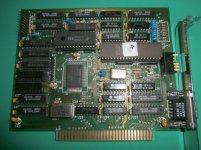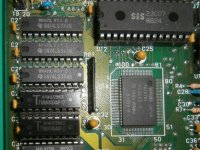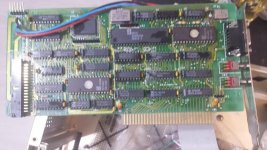Last week I acquired an 8-bit ISA card expecting to be an EGA, but after closer examination it turned out to be a CGA/MDA/Hercules, or that's what it seems to be.



I can't identify it. This should be no problem for this kind of card (usually they don't need drivers), the problem is that I'm not able to make it work on Hercules mode, and what I like most on retro hardware are Hercules graphics in a green-phosphor screen!
It has a 6 switches block, and I have tried all combinations (I think) in both an orange-phosphor EGA (CGA compatible, in theory) and a green-phosphor MDA/Hercules screen.
There are two switch combinations with readable output on the EGA screen, with 16-gray (I mean: orange) levels, so I understand that the card was working in CGA mode (while in those combinations sysinfo programs detected a CGA and an MDA at the same time).
Ahd there is one switch combination with readable output on the MDA/Hercules screen, the problem is that sysinfo programs detect a plain MDA, no trace of Hercules (and I have verified that at least some of those programs report "Hercules", not "MDA", on other Hercules compatible cards).
Althought the card is not identified, I have some information about all the chips it has:
Does anybody have any information about this card, or a similar one? (I have seen photos of other CGA/Hercules cards with Yamaha V6366-something chips) Or any idea about how to activate the Hercules mode?
There's no FCC-ID, and the only identification in the card is LD-200S, being the 2nd zero slightly bigger and rounder than the 1st, so maybe it's an "o" instead: LD-20OS
No clue about the maker, except the Texas Instruments logo on the sticker, could it be a TI card?
And the most important thing: How to make it work as an Hercules card?



I can't identify it. This should be no problem for this kind of card (usually they don't need drivers), the problem is that I'm not able to make it work on Hercules mode, and what I like most on retro hardware are Hercules graphics in a green-phosphor screen!
It has a 6 switches block, and I have tried all combinations (I think) in both an orange-phosphor EGA (CGA compatible, in theory) and a green-phosphor MDA/Hercules screen.
There are two switch combinations with readable output on the EGA screen, with 16-gray (I mean: orange) levels, so I understand that the card was working in CGA mode (while in those combinations sysinfo programs detected a CGA and an MDA at the same time).
Ahd there is one switch combination with readable output on the MDA/Hercules screen, the problem is that sysinfo programs detect a plain MDA, no trace of Hercules (and I have verified that at least some of those programs report "Hercules", not "MDA", on other Hercules compatible cards).
Althought the card is not identified, I have some information about all the chips it has:
- The biggest one is an 8748 microcontroller with EPROM, manufactured by NEC and with a Texas Instruments sticker (having a TI logo seems strange to me). The datasheet is available, but not very useful, not knowing its connection to the rest of the card, or the EPROM contents.
- The next (in size order) is a SiS 23C07 character generator with ROM, storing characters definition. It seems the newest chip in the card, manufactured in mid-1988. A very short list of features is available, too.
- The square one is a Yamaha V6366B-F, I can't find the datasheet for this chip, but I have found it for the Yamaha V6366, which should be the "family fahter", with the "B-F" being a version with added or removed features. According to the datasheet, the V6366 includes all fatures of the MC6845 and supports all CGA, MDA and Hercules modes. And on page 8 there are two configurations to be used as CGA (2 chips of 8K x 8 bit) and as Hercules (2 chips of 64K x 4 bit).
- Finally, the rest of chips belong to the 74LS series, except the 2 darker chips on the left, which are TMM41464AP-12, the datasheet is also available and they are 2 chips of 64K x 4 bits... so the card comes with Hercules memory.
Does anybody have any information about this card, or a similar one? (I have seen photos of other CGA/Hercules cards with Yamaha V6366-something chips) Or any idea about how to activate the Hercules mode?
There's no FCC-ID, and the only identification in the card is LD-200S, being the 2nd zero slightly bigger and rounder than the 1st, so maybe it's an "o" instead: LD-20OS
No clue about the maker, except the Texas Instruments logo on the sticker, could it be a TI card?
And the most important thing: How to make it work as an Hercules card?

